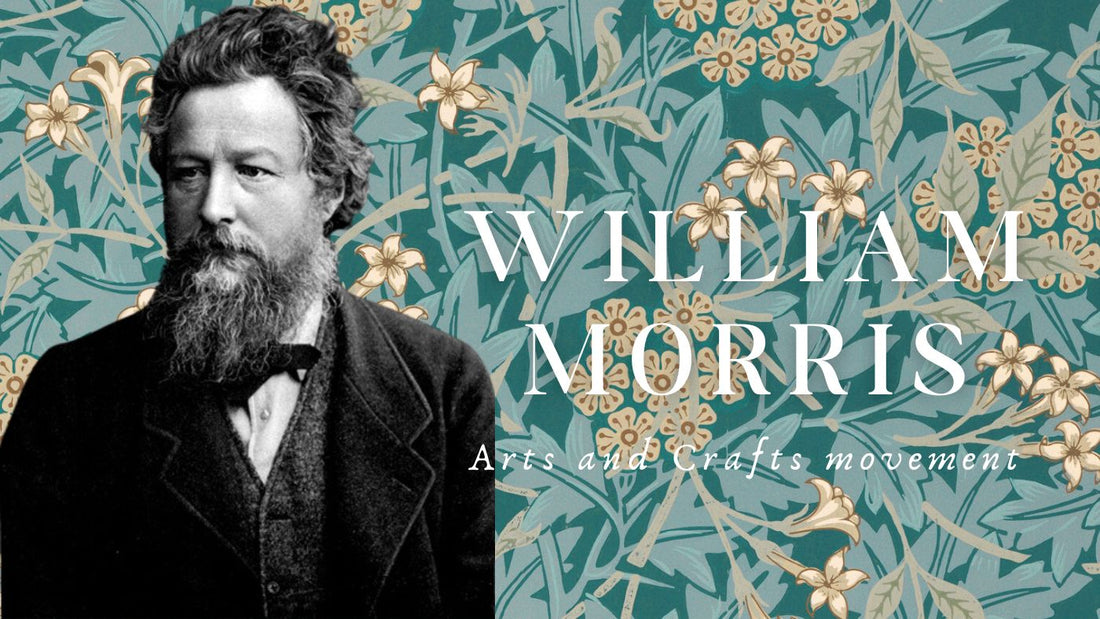
William Morris and the Arts and Crafts Movement: A Deep Dive into Floral Prints
Share
William Morris, a prominent figure in the late 19th-century Arts and Crafts movement, is renowned for his intricate floral patterns and dedication to craftsmanship. This article explores the life and work of William Morris, the principles of the Arts and Crafts movement, and the enduring appeal of his floral posters.
William Morris, driven by a wide range of interests, had a profound passion for the wonders of the past, particularly those of the Middle Ages. Known for his versatility, Morris is most recognized today as a member of the Pre-Raphaelite Brotherhood and as a pioneer in design, decorative arts, and crafts within the Arts and Crafts Movement. He aimed to revive traditional crafts and create beautiful objects accessible to many, blending aesthetics and utility to provide both creators and users with the daily satisfaction of elevating their work through beauty.
Architecture, furniture, and decoration all had to align with this ideal, exemplified in his own "Red House," which he built and lived in from 1859 to 1865. Morris even established a printing press to reinvent medieval manuscript techniques and typography during the industrial era. Between 1891 and 1898, his Kelmscott Press published 54 titles, including 17 of his own works and a famous edition of Geoffrey Chaucer's "The Canterbury Tales" (late 14th century), illustrated by the great Pre-Raphaelite artist Edward Burne-Jones.
Who Was William Morris?
William Morris (1834-1896) was a British textile designer, poet, novelist, and social activist. He was a leading figure in the Arts and Crafts movement, which sought to revive traditional craftsmanship in response to the industrial revolution's mass production and poor quality.

Early Life and Education
Born in Walthamstow, Morris showed an early interest in the medieval period, which profoundly influenced his later work. He studied at Oxford University, where he met his lifelong friend and collaborator, Edward Burne-Jones. Together, they were deeply inspired by the Gothic Revival and the works of John Ruskin.
Founding Morris & Co.
In 1861, Morris founded Morris, Marshall, Faulkner & Co., later known as Morris & Co. The firm produced a wide range of decorative arts, including textiles, wallpaper, furniture, and stained glass. Morris's designs, especially his floral patterns, became highly sought after for their beauty and quality.
 Image: William Morris's Venetian pattern
Image: William Morris's Venetian pattern

The Arts and Crafts Movement
Origins and Philosophy
The Arts and Crafts movement emerged in the late 19th century as a reaction against industrialization. It emphasized the value of handcraftsmanship, quality materials, and the beauty of everyday objects. The movement sought to bring art into daily life and promote social reform through improved working conditions for artisans.
Key Principles
- Handcraftsmanship: Emphasizing manual labor over machine production.
- Quality Materials: Using natural, high-quality materials.
- Beauty and Utility: Combining aesthetics with functionality.
- Social Reform: Advocating for better working conditions and the value of manual labor.

Image: When Mary Peyton Winlock created this jam dish and spoon, early in the 20th century, she was recognized as a master silversmith, exhibiting at the Society of Arts and Crafts of Boston (Henry Ford Museum)

The Adoration of the Magi, tapestry, wool and silk on cotton warp, 101 1/8 x 151 1/4 inches (258 x 384 cm.), Manchester Metropolitan University. Designed by Edward Burne Jones with details by William Morris and John Henry Dearle
William Morris's Floral Posters
Design and Technique
Morris's floral designs are characterized by their intricate patterns and rich colors. He drew inspiration from nature, medieval art, and Islamic design, creating timeless works that continue to captivate audiences today. His posters often featured repeating motifs of flowers, leaves, and vines, meticulously hand-drawn and colored.

Impact and Legacy
William Morris's floral posters and other designs have had a lasting impact on both interior design and the broader art world. His emphasis on quality and craftsmanship set a standard that continues to influence designers today. Morris's works are celebrated for their aesthetic appeal and are often used in modern interior decor to add a touch of elegance and history.

Image:William Morris Red House Interior
Conclusion
William Morris was a visionary whose work transcended his time, leaving an indelible mark on the world of design. His contributions to the Arts and Crafts movement and his beautiful floral posters remain a testament to the enduring value of craftsmanship and the beauty of nature. Exploring Morris's work offers not only a glimpse into a pivotal moment in art history but also inspiration for bringing art into everyday life.

